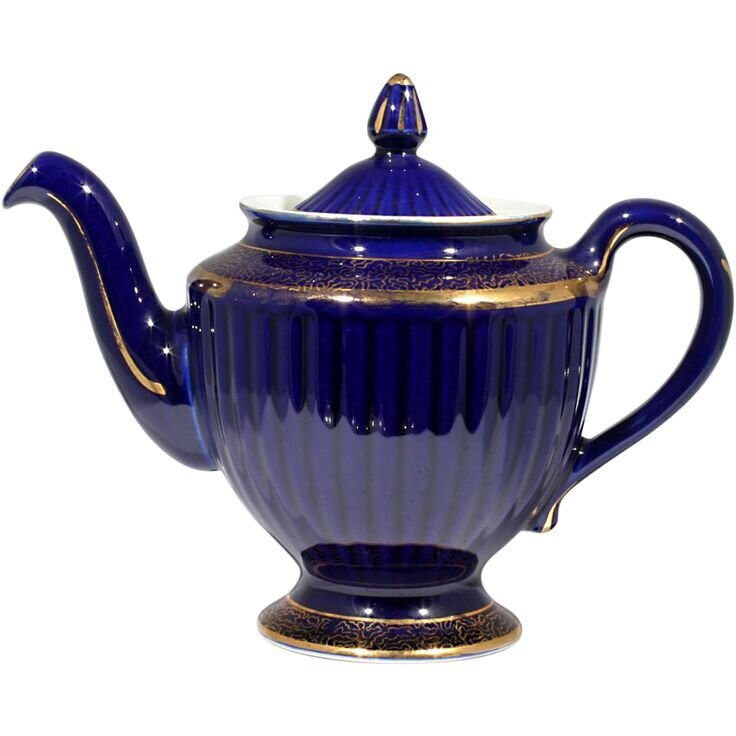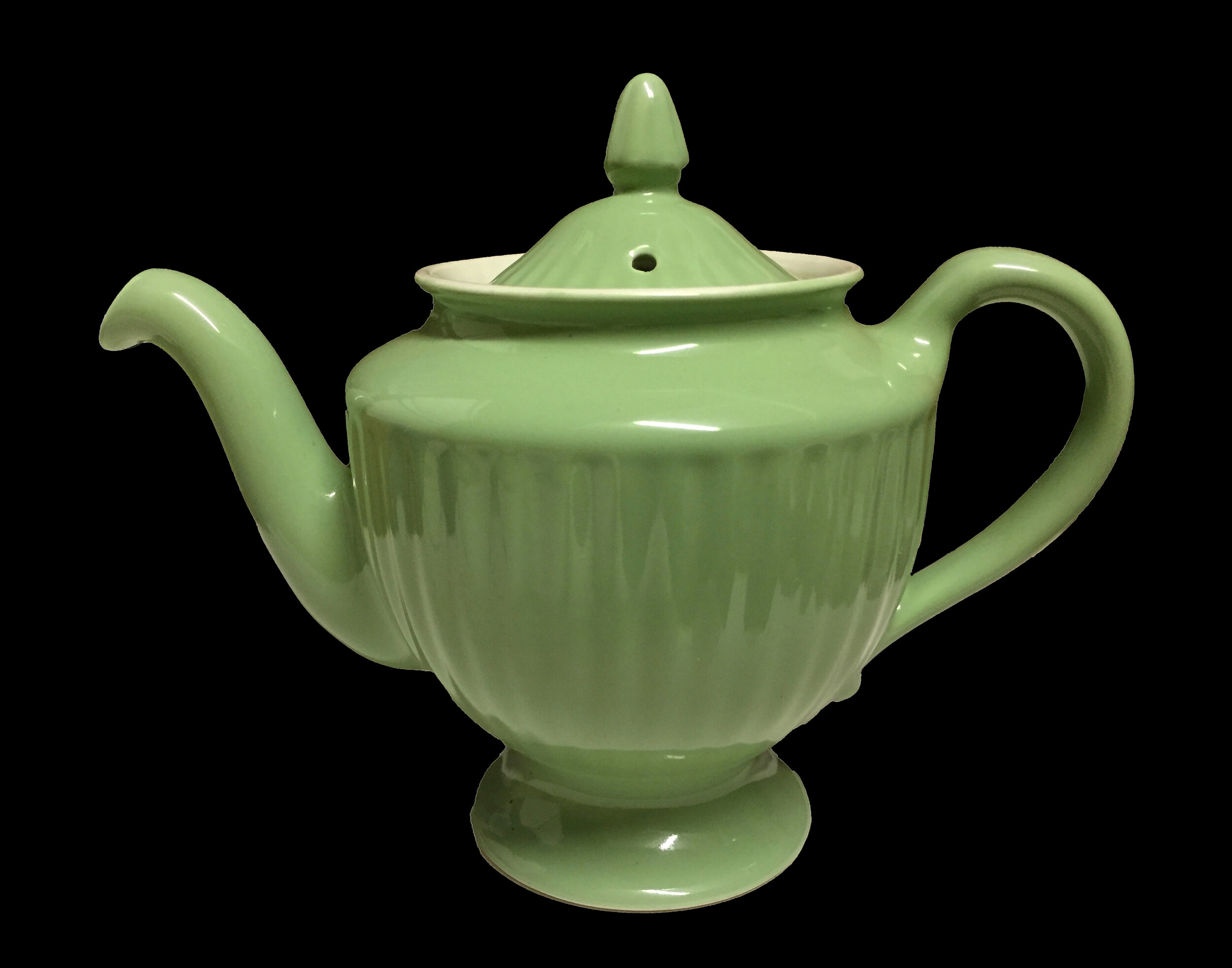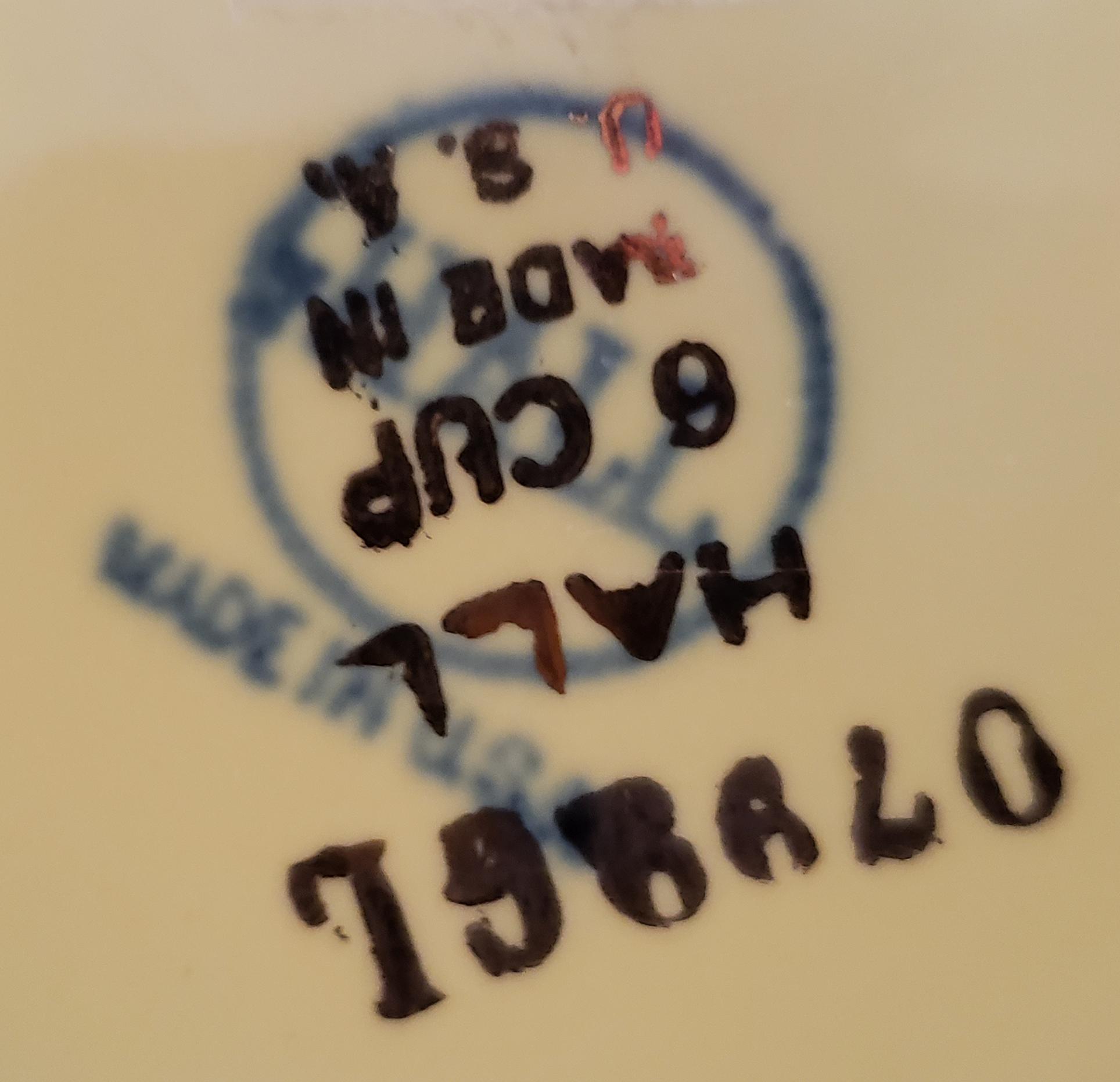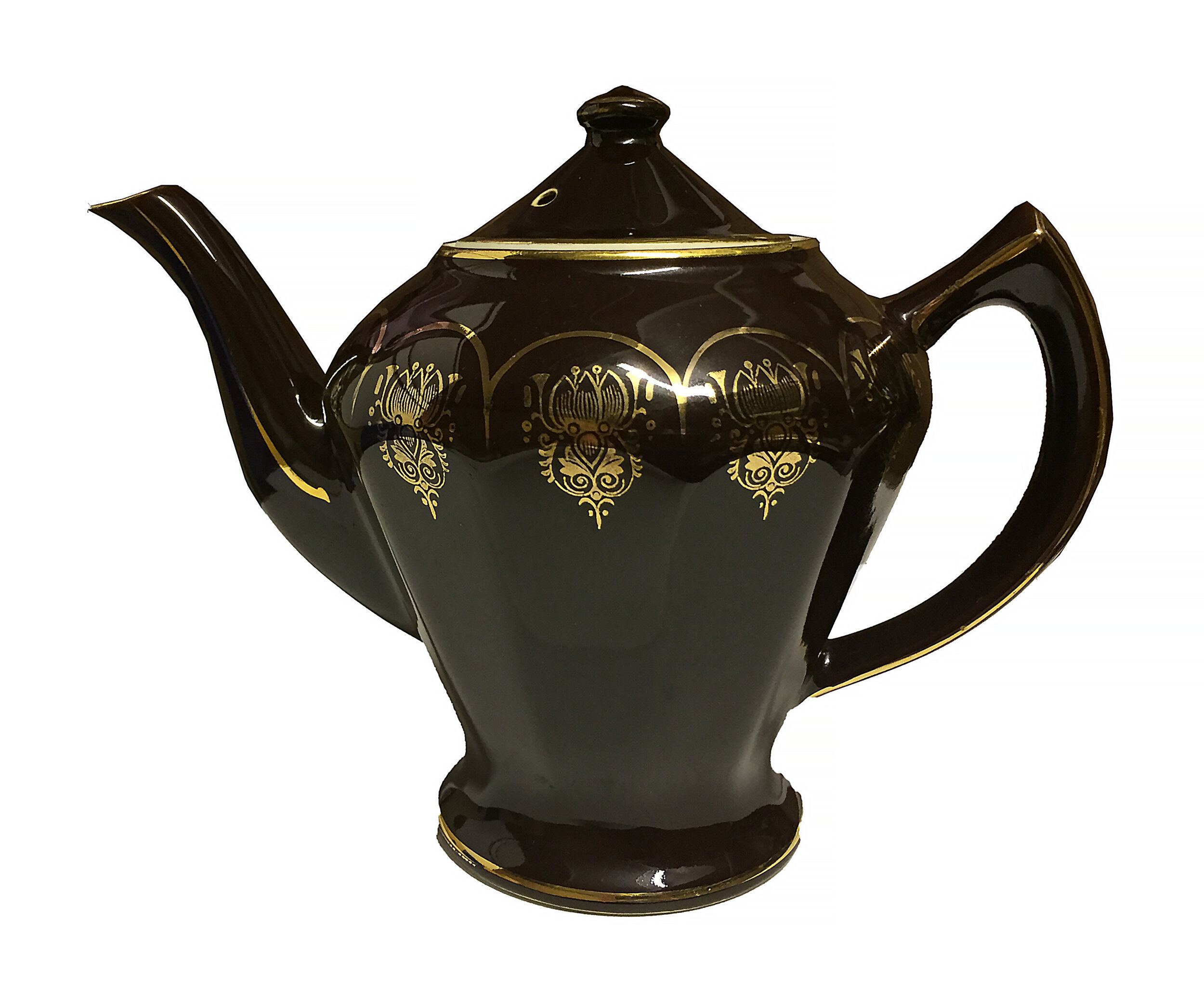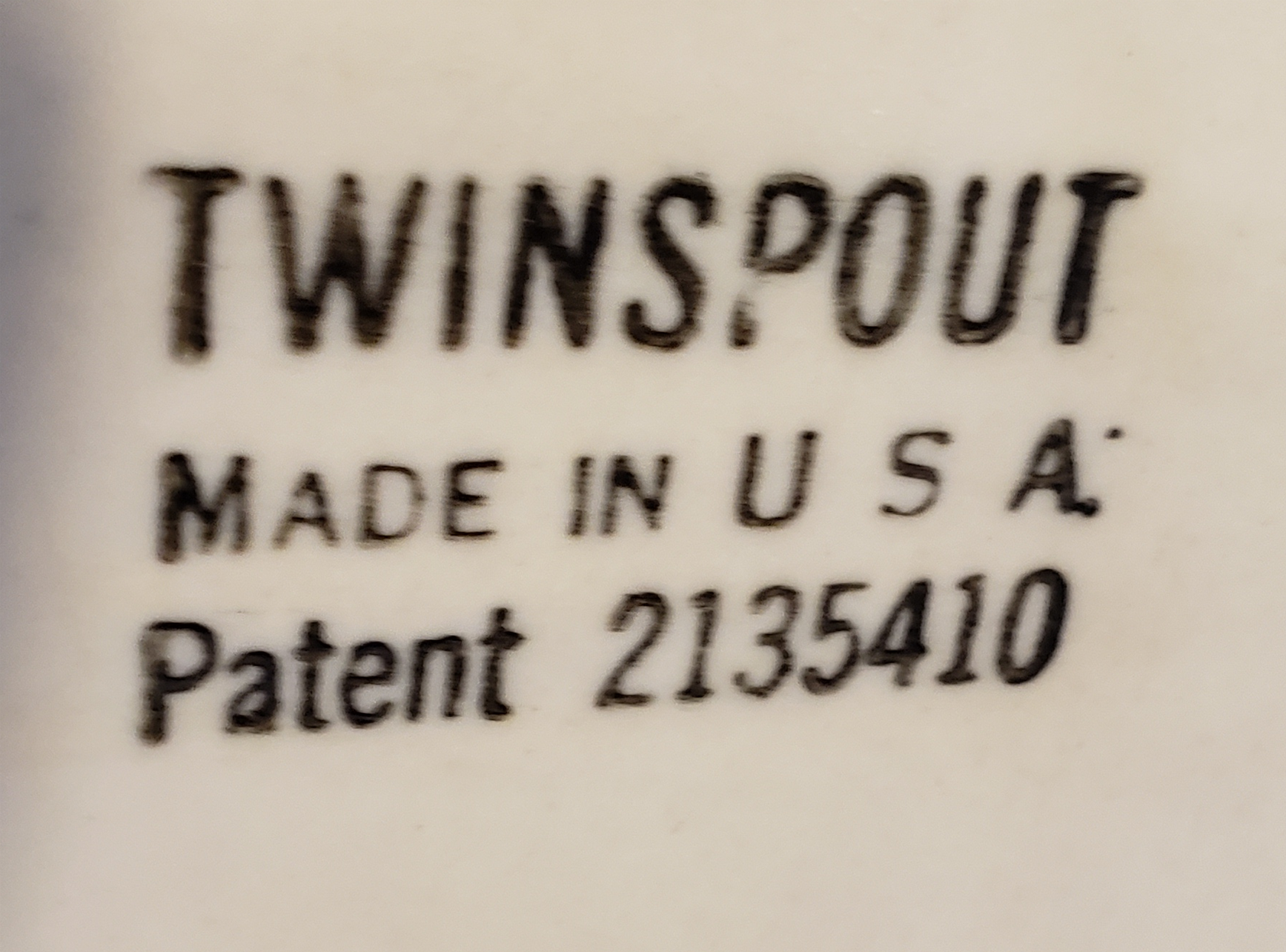Hall China Company ~ Gallery 1
“Hall’s teapots are becoming as familiar as ‘Tetley Tea.’” (1927)
Find out more about Hall China and how the company became the Teapot King in our Docent Chatroom.
Pictured are two examples of the Los Angeles teapot introduced in 1926. It was available in three sizes. The cobalt blue example is decorated with the band and lace motif while the celery green example is plain. (Barnebey, 2005).
TITLE: Los Angeles
MAKER: Hall China Company
DATE: 1926-1960s
COLLECTION: Museum of Ceramics/Ohio History Connection
Robert Hall founded the Hall China Company, in East Liverpool, Ohio, in 1903. Production of Hall teapots began in 1919 and continued until the pottery closed in 2020. The first Hall teapots, the Gold Decorated Teapot line, were extremely popular. Based on the level of popularity, Hall introduced, discontinued and re-issued many teapot lines over the years. In 1985, Hall reintroduced several of its old lines of dinnerware and teapots.
In addition to manufacturing teapots, the Hall China Company taught American homemakers how to brew the perfect pot of tea through their marketing materials.
TITLE: Pear
MAKER: Hall China Company
DATE: introduced November 1970
COLLECTION: Museum of Ceramics/Ohio History Connection
Noted ceramic designer Donald Schreckengost designed this beautiful pear shaped teapot for Hall China. He was born in Sebring, Ohio to a family of artists. Schreckengost designed pieces for the Salem China Company, the Homer Laughlin China Company and the Hall China Company. From the 1930s through the 1940s, Schreckengost designed dinnerware for Hall China. From the 1940s through the late 1950s, he worked as Director of Design at Homer Laughlin. He was also employed as a full professor and Design Department Chair of the New York State College of Ceramics. Along with his brother Viktor Schreckengost, he was awarded the prestigious Charles Fergus Binns Medal for Lifetime Achievement in Ceramic Art. In 1960, Schreckengost returned to Hall China, where he produced notable pieces such as the duck casserole dishes, owl cookie jars, Sherlock Holmes and Ronald Reagan teapots, and commemorative whiskey decanters. Tile designs by Schreckengost were produced at Summitville Tile (Ohio). Schreckengost's work has been displayed in the Cooper-Hewitt National Design Museum, the Schein-Joseph International Museum of Ceramic Art, and the Smithsonian Institution. (Donald, 2020).
This canary colored teapot has the gold squiggle design in the Gold Label Series. It has a hook cover lid and a non-slip handle. The Parade was introduced in the early 1940s but was not offered as a gold decorated teapot until the mid 1950s. (Barnebey, 2005, Whitmyer, 1997).
TITLE: Parade
MAKER: Hall China Company
DATE: mid-1950s-1960s
COLLECTION: Phyllis Conley
In 1905 Robert Hall Jr., following the untimely death of his father just one year after the founding of the Hall China Company, began working on a new single-fire process. In 1911, the company began using the process that allowed the glaze to adhere to the wet ware in one single firing. This new process made the ware strong and durable, without crazing. Crazing (cracking of the glaze) had been a problem of the two firing process.
TITLE: Hollywood
MAKER: Hall China Company
DATE: introduced 1927
COLLECTION: Museum of Ceramics/Ohio History Connection
The Hollywood shape teapot was available in a four, five, six and eight cup sizes. This example is in Matte Orchid with the gold decoration seen on the “Gold Decorated Group 8 teapots. (Barnebey, 2005, Whitmyer, 1997).
TITLE: Aladdin (Oval)
MAKER: Hall China Company
DATE: 1939-1963
COLLECTION: John and Peg Thompson
The Aladdin teapot has been one of the Hall China Companies most popular shapes. It is found in round opening, oval opening, both with and without infusers, and in narrow and wide bodies. There are several examples in the exhibit of these iconic teapots.
TITLE: Victorian Series
MAKER: Hall China Company
DATE: 1946-1949
COLLECTION: John and Peg Thompson
Benjamin
Murphy
Connie
Plume
Bowknot
The Victorian series of 6 teapots (the Birch is not pictured) was not a very successful line for the Hall China Company. By the end of the 1940s it had been discontinued in favor of the Brilliant series. (Whitmyer, 1997, Barnebey, 2005).
TITLE: Sani-Grid
MAKER: Hall China Company
DATE: 1940s
COLLECTION: Museum of Ceramics/Ohio History Connection
The Sani-Grid style first appeared in the 1941 Hall China Special Catalog # 4. Made in three and six cup sizes, the spout was made with a grid to catch the tea leaves and was also shortened for easy cleaning.. The style, often referred to as “pert” was easier to store. (Barnebey, 2005, Whitmyer, 1997).
Tea Trivia:
Loose tea remains good for use for about two years, provided it is kept away from light and moisture. Tea bags, however, are only good for about six months before they start to lose flavor and quality. (Kenna, 2021).
TITLE: Windshield
MAKER: Hall China Company
DATE: introduced in 1941
COLLECTION: Museum of Ceramics/Ohio History Connection
The Windshield is described as representing the collar worn by Queen Elizabeth I. The style is echoed in the later Thorley design known as Windcrest or Bronte. (Barnebey, 2005).
Tea Trivia:
What is a tisane?
The word tisane was originally used to describe a drink made from pearl barley. However, it is now used to describe a tea-styled drink that contains herbs, such as mint and lavender, or other items but NO tea. For example, a tisane can be made from nuts, seeds, berries, flowers, leaves, or roots. (Boutwell, 2019).
TITLE: Philadelphia
MAKER: Hall China Company
DATE: 1920s
COLLECTION: Museum of Ceramics/Ohio History Connection
The Philadelphia shape teapot was produced in seven different sizes, ten, seven, six, five, four, three and one and a half cups.
The Philadelphia teapots were one of the first to be decorated with gold trim. This example is the standard gold decoration. (Barnebey, 2005).
Tea Trivia:
Fresh water should always be used when making tea. Water that has been boiled previously has lost oxygen which can make the tea taste flat. (Kenna, 2021).
TITLE: Albany
MAKER: Hall China Company
DATE: introduced 1929
COLLECTION: Museum of Ceramics/Ohio History Connection
The Hall Albany teapot has a look-a-like! The Albany and Ceylonator (intoduced in the 1930s) shapes are very similar and can be mistaken for each other. However, the Ceylonator has an infuser and an Albany lid will not fit a Ceylonator. This example is black with the gold decoration. (Whitmyer, 1997, Barnebey, 2005).
Tea Trivia:
Chester, West Virginia lays claim to the “World's Largest Teapot!” The 14-foot-tall structure was built in 1938 as an advertising barrel for a Hires root beer stand in Oakdale, Pennsylvania. Converted to a teapot with the addition of a spout, handle, and lid, the building served as a concession and souvenir stand for William Devon’s pottery outlet on Carolina Avenue. The teapot closed around 1971. It was later moved and suffered years of neglect before it was rescued and restored it to its former glory by volunteers. It now stands at the east end of Chester on Carolina Avenue at the intersection of Route 30. (Jourdan, 1991).
TITLE: Globe
MAKER: Hall China Company
DATE: Late 1930s -1940s
COLLECTION: Museum of Ceramics/Ohio History Connection (H28812 in green)
One of two Globe shaped teapots produced by Hall. The No-Drip is a Globe shape teapot with a different spout and decoration. The Globe teapot, introduced in the late 1930s, was usually found with the gold decoration pictured. By 1942 it was available in black, blue, brown, cadet, canary, delphinium, Dresden, emerald, green, green lustre, ivory (pictured), marine, maroon, orchid, rose, turquoise and yellow. (Barmebey, 2005).
TITLE: Automobile
MAKER: Hall China Company
DATE: introduced in 1938
COLLECTION: John and Peg Thompson
The Automobile was one of the Hall China Company’s Novelty teapots introduced in 1938. Although it has a very unusual shape it was very popular. The Autumn Leaf example pictured here was produced in 1993 to commemorate then 60th year of the Autumn Leaf decoration (1933). Autumn Leaf was introduced as a premium when customers purchased other items. (Whitmyer, 1997).
TITLE: Twinspout
MAKER: Hall China Company
DATE: patent issued 1938
COLLECTION: John and Peg Thompson
The Twinspout was invented by Oscar Ottoson who applied and was awarded the patent in 1938. The Twinspout was made by the Hall China Company for The Twinspout Pottery Company of New York. When the lid is removed there are two openings, the larger for the tea and the smaller for the hot water. (Barnebey, 2005).
TITLE: Streamline
MAKER: Hall China Company
DATE: c. 1937
COLLECTION: Museum of Ceramics/Ohio History Connection
The example pictured here has the standard gold decoration around the top, edge and on the spout. Introduced in the early 1930s the Streamline was added to the Gold Decorated line in 1937. (Barnebey, 2005).
TITLE: Hook Cover
MAKER: Hall China Company
DATE: introduced 1940
COLLECTION: Museum of Ceramics/Ohio History Connection H28812
The Hook Cover teapot was advertised as having a lid that would not fall off when pouring. This style of teapot was only produced in the six cup size. The body has a hook over which the lid fits. The example pictured has the standard gold decoration of a large flower with four prigs on the body. There is gold trim around the pot top and down the handle. (Whitmyer, 1997).
TITLE: Boston Knob
MAKER: Hall China Company
DATE: 1916+
COLLECTION: John and Peg Thompson and the Museum of Ceramics/Ohio History Connection
The Boston shape came in two styles, the Boston Knob, included here, and a teapot with a sunken lid (below). The Boston is one of Hall China Company’s earliest and most enduring styles. It is found in seven sizes from one cup to seven or eight cup. In 1916, the McCormack Tea Company purchased the Boston in the seven cup green. The seven cup green and brown Boston were the first Hall teapots carried by the Jewel Tea Company in 1924. In the 1930s Hall changed the cup sizing on the Boston and other teapots. The Boston shape was still in production in the 2000s. (Barnebey, 2005).,
Museum of Ceramics/Ohio History Connection
John and Peg Thompson
Tea Recipe:
GLOW GREEN SMOOTHIE: Pour 2 cups freshly boiled water over 4 Twinings Wellness-Glow teabags and steep for 5 minutes. Remove bags and refrigerate until cold. In blender mix tea, 1 small avocado (pitted and peeled), 1 cup spinach, 1 cup frozen pineapple, ¼ cup quick-cooking oats, and 1 cup ice until smooth. Divide into 2 glasses. (Twinings).
The Boston teapot with the sunken lid comes in four sizes. Hall introduced four shapes of teapots at the Pittsburgh Trade Show in 1920 as it began to enter the retail market. The example in green is a Boston with a short metal tip and was introduced in 1964. (Barnebey, 2005, Whitmyer, 1997).
TITLE: Boston Sunken lid
MAKER: Hall China Company
DATE: 1916 +
COLLECTION: John and Peg Thompson
Tea Recipe:
SANGRIA TEA: Pour 3 cups boiling water over 5 teabags and brew for 5 minutes. Remove and squeeze teabags. Add 2 cups no sugar added grape juice, I medium orange sliced, 1 medium lemon, sliced, 1 medium lime sliced and chill at least 2 hours. Just before serving add 1 ½ cups club soda. Pour into ice filled glasses. (Lipton).
TTITLE: Musical
MAKER: Hall China Company
DATE: 1930s
COLLECTION: Museum of Ceramics/Ohio History Connection
The musical teapots were not a great success although they continued in production for China Specialties. The music box, which was advertised as playing “Tea for Two,” sits under the teapot in a “well” and is held in place with a spring clip. Often, the teapot would be washed without the removal of the musical box causing damage to the mechanism. (Barnebey, 2005).
Tea Recipe:
BERRY QUICK CITRUS ICED TEA: Pour 2 cups boiling water over 2 Lipton Iced Tea Family Size teabags, cover and brew 5 minutes. Remove and squeeze teabags. Process tea, 1 bag (12 oz) frozen mixed berries and 1 cup orange juice in a blender. Pour into pitcher and add 2 cups chilled seltzer. Garnish with berries or orange slices. (Lipton).
TITLE: Tea For Two
MAKER: Hall China Company
DATE: 1930-1996
COLLECTION: Museum of Ceramics/Ohio History Connection
A teapot and a hot water pot, the Tea for Two set is distinguished from the Twin-Tea set by the sloped shape of the body, It can also be found as a Tea for Four set. The example pictured is a Tea for Two with the Tulip and Carnation decal. (Barnebey, 2005).
The decal is immersed in water to release it from the backing and is slid onto the item, making sure that the decal is the correct side out. A sponge or squeegee is used to remove water and any air bubbles. The item is set aside to dry for approximately 24 hours and then fired again. During the final firing the decal becomes a permanent decoration on the item.
